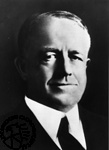Great Throughts Treasury
This site is dedicated to the memory of Dr. Alan William Smolowe who gave birth to the creation of this database.

Frank Bunker Gilberth, Sr.
American Businessman, Early advocate of Scientific Management and a Pioneer of Motion Study, best known as the father and central figure of "Cheaper by the Dozen"
"We're worn into grooves by Time - by our habits. In the end, these grooves are going to show whether we've been second rate or champions, each in his way in dispatching the affairs of every day. By choosing our habits, we determine the grooves into which Time will wear us; and these grooves that enrich our lives and make for ease of mind, peace, happiness - achievement."
"Advancement of the human factor in industry... varies so much that unless we use measurement and abide by the results, there is no possibility of repeating the process accurately and efficiently at will, or of predicting and controlling the future conditions that assure that advancement."
"All human activity is a matter of motion and decision."
"Motion Study is a means to permanent and practical waste elimination, — hence a prerequisite to efficient preparedness that shall be adequate, constructive and cumulative."
"No definite and permanent advance is made in any kind of work, whether with materials or men, until use is made of measurement."
"Process-chart notes and information should be collected and set down in sketch form by a highly intelligent man, preferably with an engineering training and experience, but who need not necessarily have been previously familiar with the actual details of the processes. In fact, the unbiased eye of an intelligent and experienced process-chart maker usually brings better results than does the study of a less keen man with more special information regarding present practices of the processes. The mere act of investigating sufficiently to make the notes in good enough condition for the draftsman to copy invariably results in many ideas and suggestions for improvement, and all of these suggestions, good and bad, should be retained and filed together with the description of the process chart. These suggestions and proposed improvements must be later explained to others, such as boards of directors, managers and foremen, and for best results also to certain workmen and clerks who have special craft or process knowledge. To overcome the obstacles due to habit, worship of tradition and prejudice, the more intelligence shown by the process-chart recorder, the sooner hearty cooperation of all concerned will be secured. Anyone can make this form of process chart with no previous experience in making such charts, but the more experience one has in making them, the more certain standard combinations of operations, inspection and transporting can be transferred bodily to advantage to the charts of proposed processes."
"The aim of the process chart is to present information regarding existing and proposed processes in such simple form that such information can become available to and usable by the greatest possible number of people in an organization before any changes whatever are actually made, so that the special knowledge and suggestions of those in positions of minor importance can be fully utilized."
"The first step in any great movement is to... arouse interest in the subject, to discuss the great problems involved, to outline the possible solutions, and to assign the various problems to those best fitted to undertake and handle them. The next step is to realize that all this discussion, valuable as it is, can grow into such action as it deserves, only if measurement is insisted upon from the very beginning of making the investigations outlined, if the records of measurement are in such form that they can be used by those who did not make them, that skill and experience may thus be transferred, and if the results of the measurements are incorporated into actual and universal practice as soon as they are properly synthesized into practical methods of least waste. The world has come to realize the truth of this as applied to material things. The day of standardization of materials and of machines is far advanced, and is daily progressing; but such has been rarely the case with measurement as applied to the human element."
"The greatest misunderstandings occur as to the aims of scientific management. Its fundamental aim is the elimination of waste, the attainment of worth-while desired results with the least necessary amount of time and effort. Scientific management may, and often does, result in expansion, but its primary aim is conservation and savings, making an adequate use of every ounce of energy of any type that is expended."
"The Process Chart is a device for visualizing a process as a means of improving it. Every detail of a process is more or less affected by every other detail; therefore the entire process must be presented in such form that it can be visualized all at once before any changes are made in any of its subdivisions. In any subdivision of the process under examination, any changes made without due consideration of all the decisions and all the motions that precede and follow that subdivision will often be found unsuited to the ultimate plan of operation."
"There is no waste in the world that equals the waste from needless, ill-directed and ineffective motions."
"There is some confusion today as to the meaning of scientific management. This concerns itself with the nature of such management itself, with the scope or field to which such management applies, and with the aims that it desires to attain. Scientific management is simply management that is based upon actual measurement. Its skillful application is an art that must be acquired, but its fundamental principles have the exactness of scientific laws which are open to study by everyone. We have here nothing hidden or occult or secret, like the working practices of an old-time craft; we have here a science that is the result of accurately recorded, exact investigation."